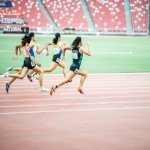Significant Injuries Through Out the Games

The Olympic Games are often viewed as showcasing the world’s best talent in their events. We give praise to seasoned veterans based on nothing but their abilities without thinking much about their character out of the arena. This past week during the Women’s 5,000 Meter Race, two athletes whom had never met before, displayed powerful acts of kindness in an otherwise devastating time.
Abbey D’Agostino from the United States showed her true colors when another competitor took a tumble towards the end of the three mile race. Nikki Hamblin of New Zealand fell directly in front of D’Agostino, giving her no time to get out of the way, causing her to inevitably fall as well. Instinctively, D’ Agostino jumped up and assisted Hamblin to her feet, encouraging her to finish the race.
It was D’Agostino that needed Hamblin’s help as she limped across the finish line. She was taken by wheelchair off the and later examined by medical professionals and diagnosed with a sprained MCL, a torn meniscus, and complete tear of the ACL. The ACL is the ligament that connects the tibia (main lower leg bone) to the femur (thigh bone). Without this structure, the knee is relatively unstable.
Approximately 200,000 ACL injuries are reported each year, making it one of the most common injuredstructures in the knee. Fifty percent of ACL injuries occur with additional damage to the meniscus and MCL, which is commonly referred to as the ‘Unhappy Triad”. Treatments can vary depending on the severity of the damage to the structures. Partial tears with no instability or children who have ACL injuries can usually rely on non-surgical treatment. Physical therapy and patient education are key elements in non-operative treatment of this injury.

In other cases when there is a rupture of the ligament, or several damaged structures, surgery is often recommended. Ligament repairs at this site tend to fail, so the standard for surgery is an autograft. An autograft is when you take a structure from the individuals own body and use it for another purpose. In this case, a section from either the hamstring, quadriceps, or patellar tendons would be used in its place.
This surgery is often very successful and most people make full recovery in six to twelve months. Physical therapy and the use of a functional brace is key to protecting the autograft from re-injury following surgery. Complications to surgery are rare, but include stiffness, blood clots, or re-rupture with future injury. If you suspect that you have injured a knee structure, contact your doctor for the treatment option that best fits your needs.
By: Riki Duncan, MA. Ed

